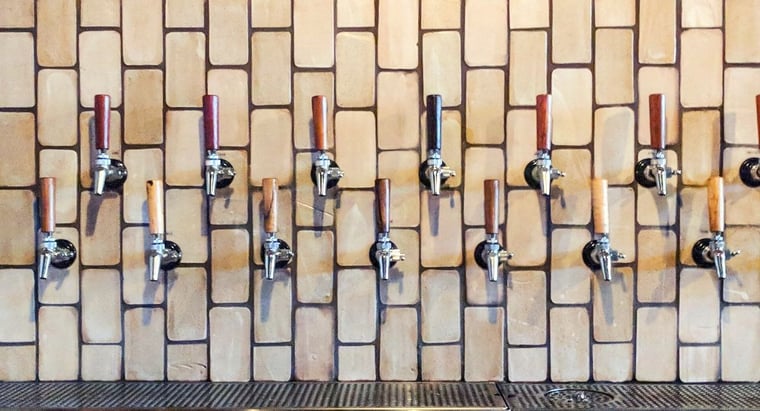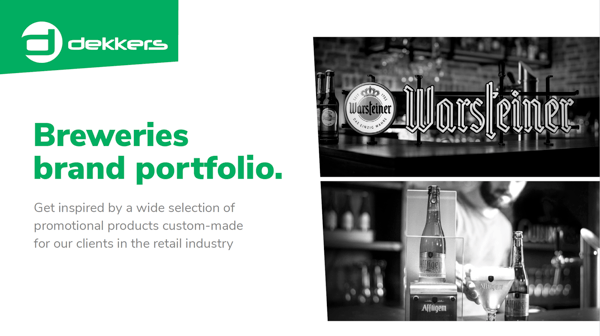 We talked to Chief Economist Bart Watson from Brewers Association.org about the latest craft beer market insights, risks and opportunities. Bart's profile information shows that he is a stats geek, beer lover, and Certified Cicerone®. In our interview, all of these points were firmly confirmed, and his passion for the field was evident.
We talked to Chief Economist Bart Watson from Brewers Association.org about the latest craft beer market insights, risks and opportunities. Bart's profile information shows that he is a stats geek, beer lover, and Certified Cicerone®. In our interview, all of these points were firmly confirmed, and his passion for the field was evident.
We asked Bart to briefly give us an overview of the current market dynamics and the main challenges and opportunities that new or established craft brewers experience. He shared his insights and gave every craft beer brand builder can pick from valuable tips. This interview is a special edition celebrating the long-awaited Craft Brewers Conference in Minneapolis this year. You can download the total dedicated craft brewery content package here.
The strongest craft brewers are those that can adapt
The craft beer market in the US has seen a double channel shift from pre to post COVID conditions. These shifts had a massive impact on drinking habits, location of drinking and thus distribution strategies. The ability of brewers to adapt to fast-changing circumstances and (re) innovate repeatedly was the critical factor to staying afloat. Now, with the recovering draught market and channels opening up again, the challenges with the supply chain, raw material shortages and inflation are causing new waves that need to be tackled.
Luckily, craft brewers reap benefits by following a focused strategy, using hyper differentiation and going deeper into local markets and their own brand story. Not to mention upcoming consumer trends that, when relevant, can be valuable additions to their overall craft brewery branding. Read on for more in-depth answers from Bart Watson.
1. Q: Could you give a brief overview of what you do for craft brewers at Brewersassociation.org?
I'm the chief economist at Brewersassociation.org and have been since 2013. My role is to track the markets and provide valuable data or statistics to help our members. This could be anything from general market tracking, industry benchmarks or sharing insights on raw material suppliers like hop and barley. There are massive amounts of information available, so helping members find specific information and data points they can use for their business plan or shape their thinking about the market.
2. Q: If you look at the craft brewing industry in general, in the US, how would you describe its current state?
I think it's still a little bit in flux. The COVID pandemic posed many challenges for small brewers, primarily because they tend to sell more beer on-site at their breweries and in the distributed draft to bars and restaurants. So 2020 was a challenging year because of the channel shift we experienced, where we generally drank about as much beer as before. Still, we drank it in very different places—buying more packaged beer from other stores, grocery stores, and convenience stores and buying less from bars and restaurants. That shift inevitably hurt craft brewers who, before the pandemic, were more like 40 or 45% draught versus the overall beer market in the United States, which is only 10% draft. So 2021 has been a bit of a reverse of that. So, we've seen a bounce back from craft brewers, as the draft market has returned, it's still not fully back to where it was, I think we're still 15 to 20%. below where we were in 2019. But certainly, that's a lot better than 2020, where those sales largely disappeared.
3. Q: What would you say then are the current challenges for craft brewers?
There are a lot of challenges on the horizons for craft brewers right now; even as sales have returned, the supply chain and rising costs are posing problems for a lot of them. And so, you know, we're seeing breweries start to get back to volumes that they were at, but margins are pressed and along been we're struggling, both with the availability of materials and the cost of those materials.
4. Q: Can you tell how these shifts impact brewers specifically?
I think it varies by the business model. So if you're a brewery whose packaging is primarily in cans, the price of aluminium cans matters a lot. If you're a public brewer who sells everything on draft, then it doesn't matter, and you probably care more about the price of steel for kegs. But for the price of barley or other inputs, we see that these costs are generally pressing margins for all brewers when energy prices go up, and labour prices go up. I mean, that affects everyone. So, every brewery feels this, but they are feeling it in very different ways.
5. Q: Would you say the impact is felt more with larger or smaller craft breweries?
You're seeing the large global brewers talk about this in their calls, but large brewers are much more likely to have long term contracts and have the scale to push back against price increases. They also often control large pieces of their supply chain. For example, Anheuser-Busch (InBev) in the United States owns a significant portion of its malt production, makes many of its cans, and grows many hops. So while they're still feeling the impact of price increases in some places, they have a better ability to control it. Whereas small brewers dependant on spot markets are subject to the market much, much more.
6. Q: Are these trends impacting the number of newcomers to the craft brewing industry?
It could, and we saw that already. I mean, that kind of transition. We've seen a decrease in the number of breweries, we're still seeing growth, but we've seen a decline in openings fairly consistently. And this started before COVID. So, some of this was just a maturing of the US market. A few years ago, we had 1200 breweries opening a year; the next year was 1000, then 800. And last year, we were closer to 600. So we see a fairly linear decrease in the number of breweries opening. The flip side of that is that closings haven't increased that much. We certainly saw elevated closings in 2020. As some people feared, it wasn't a huge spike, primarily driven by government support; the US government pumps $1.5 billion into breweries.
7. Q: If you decide to enter the market, what are the main tactics or strategies you should focus on when it comes to branding or winning marketing tactics?
I think there are still many dimensions where you can stand out in the market. They involve having a very focused strategy, whether in product or brand, market location or a specific business model. And I think what we've seen over the last few years is that the era of being able to do everything well has been reduced. I mean, we have over 9000 breweries in the United States. So, there is a good chance that somebody is doing almost everything. So, breweries have to focus on where and how they stand out. We could talk for an hour about how you differentiate, and it sounds like that's some of the work you do. But, I think there's a variety of ways to do that. With their products, branding, and social causes, and increasingly for many consumers, it's about what your brand stands for. So brewers, I think, are focusing more on that and how they tell that story. For example, when you buy our beer, it goes to create trails or clean water or whatever the brand believes in.
8. Q: And what would you say are some new opportunities in the market?
There are new opportunities and some of the unique attributes that we're seeing in the next generation of legal drinking age drinkers. One of these that we've seen emerge in the last few years is non-alcoholic, which is still very small in the US market compared to many European markets. But, still, it's growing very rapidly and marks a change as non-alcohol has always been a market in the United States characterized mainly by the lack of alcohol and one that had a stigma around it for people who didn't drink. And increasingly, it's a market with a lot of the attributes of craft shows about variety about flavour, you know, and there isn't that same stigma anymore.
9. Q: Are there any challenges in the non-alcoholic trend as a craft brewer?
I think there are some challenges if you're really small. There are technical challenges in making these products. So I don't think your local pub will be making non-alcoholic beer anytime soon. But, this broader trend around kind of consciousness and mindful drinking offers opportunities for brewers of all sizes. So I would differentiate those two a little bit where non-alcoholic is always going to be a bit more of a scale game just because of the technical challenges in producing those beers. But there are opportunities for brewers of all sizes as they think about one of the drivers leading the non-alcoholic market to grow. Even if they're not making non-alcoholic beers, may there be ways to engage with those consumers, many of whom are still drinking beer and so one you know, one product with different functional attributes that have alcohol and some that don't.
10. Q: Are there any other trends craft brewers should look out for?
In consumer trends in the US, we've seen this growth in what's often now called a fourth category. So things that are in cans at a similar ABV point are beer, but not beer. So, malt beverages and hard seltzer were the first turns, but now we're seeing hardcore kombucha, canned wine, and canned cocktails. And that space, in general, is a growing one. It's one that some small brewers are entering into. Still, I think all small brewers see competitive effects in shelf space - getting pressed by these products because they play with similar consumers as craft beer drinkers as a lot of the products are defined by flavour and variety. So that's, that's less a trend kind of for the breweries themselves, but one within the beverage alcohol space that is undoubtedly affecting the craft industry.
11. Q: What would you say are the strongest distribution channels?
The strongest channels have always been the kind of broadest distributed in the US - packaged, particularly chain retail, that doesn't necessarily work for many brewers who don't have the scale. So many brewers are focused on regrowing in on-trade, which is significant for many of them and often matches their scale much better. Smaller independent operators work better with small brewers who don't have the scale to have a chain team and supply the number of stores. I think we also see pressure on distribution. We saw in the pandemic that many in the distributor tier look to reduce skews. I think that's been confirmed in the trade as well, that while the on-trade has come back, many on-trade operators have looked to get fewer brands and more consistent brands that they know will stay in stock that they know will move. So we've seen, for example, still that the number of tap handles on average has been reduced from pre-COVID levels. So a little bit less of that kind of long tail of variety. But I think brewers are hoping to rebuild that going forward. One other small channel that we've seen more brewers get interested in exploring is direct to consumer. Although this is not legal everywhere. We've seen mainly the delivery that happened early in the pandemic go away, it's complicated, and it costs a lot. But brewers, particularly those with speciality products, are looking more at things like direct to consumer shipping, or clubs - that kind of model - either pick-up or shipping.
12. Q: Would you say there is also a shift to a more local strategy?
I think this is another place we're seeing the middle get put under pressure. The very local is growing and still has a place and then there's kind of a threshold where I think there's a lot of opportunities. But, still, you have to get to a scale where the larger distributors, the large or change, the larger retailers want to take on your products. And the real challenge is being in between those two places where you're not local. And so you don't have scale locally. But you're not big enough that some of the mega distributors and retailers want to focus on your products. But we certainly continue to see growth and local both from consumer demand points and a brewer strategy. And I think many breweries are increasingly trying to deepen their footprints in their locality, as opposed to a few years ago, we saw them trying to expand their geographies. So, you know, now they're trying to go deep in the landscapes they're already in as opposed to just developing across the country.
13. Q: What would you say was the key formula for staying afloat or winning in these changing market dynamics?
We saw the market totally changed. I mean these dramatic, rapid changes you ever get in markets over the last two years, and then, as quickly as they change one way, it's been changing back another way. And so companies that we're able to adapt, adapt their sales force, adapt their production strategy have been ones that I think have largely been the most successful. So, I would say broadly, the fact that we saw such a low percentage of breweries go out of business shows that the lots of breweries had been successful in this regard. There are certainly many breweries that have shown their ability to adapt and innovate.
14. Q: So, what would you advise to new brewers entering the market?
I say this fairly consistently when I speak to new brewers, which is they need to be very focused on what it is new that they are bringing to the marketplace. Is it new beers? Is it new geography that isn't already being served by a craft brewer? Is it a new business model? Is it a new set of products? In the era of 9000 plus breweries in the United States, bringing good beer is the baseline. You need to do something more to stand out. And so brewers should have a very clear sense of, who they are, and how they're going to succeed as they enter the marketplace. So, I think having a kind of a conscious strategy that you focus on is more important than ever.






